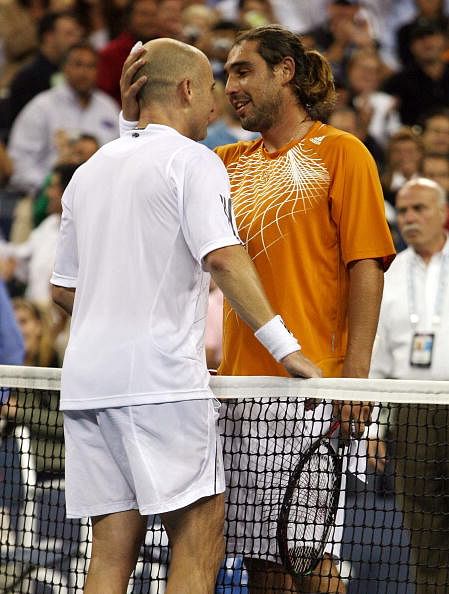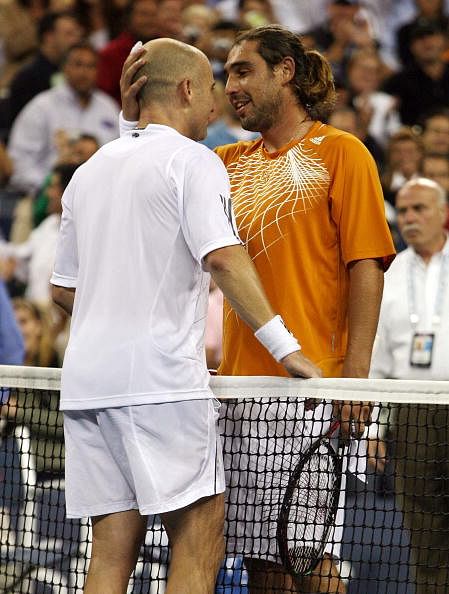
US Open Classics: Andre Agassi vs Marcos Baghdatis, second round, 2006

Marcos Baghdatis, right, of Cyprus congratulates Andre Agassi after the match
Scroll down to watch the full highlights of the epic match.
It was the second round. He wasn’t supposed to win.
The entire world turned to Arthur Ashe stadium to bid farewell to a man who was a sporting icon for an entire generation of tennis fans. They realised his time was over.
At 36, tennis professionals watch the sport in front of a television. Agassi had been defying odds for years, but in 2006 he declared he had had enough. Playing in front of his favourite home crowd, Agassi was giving it one final push.
Except that he drew Marcos Baghdatis in the second round.
Baghdatis had been in scintillating form the entire year. He reached the final of the Australian Open and the semi-finals of Wimbledon, and was seeded eighth at the Open. In many ways, he was exactly like a reflection of a younger Agassi himself. Their playing styles were almost identical. Both were classic counter-punchers, both swung at the ball as early as possible and both were fierce returners. The only difference between them was 8 Grand Slams, 15 years of age and 25,000 American fans.
Agassi had been in terrible health. He had been receiving anti-inflammatory shots for his sore back. He was a medical wreck on court. Everyone on the circuit and on court knew this. They came for what they thought would be a comfortable win for Baghdatis and a respectful exit for Agassi.
And then the match turned into one of the most dramatic turn of events on the centre court.
Agassi took the first two sets in a fairly text-book style. His strokes were consistent-damaging as ever. He was returning well. Baghdatis simply couldn’t make it click. In the beginning of the third, Agassi even hit a shot between his legs after winning a point. He was leading 6-4, 6-4.
Tennis is a beautiful game. A match can last for an hour. A match can go on for a day. There’s no telling what a simple break of serve can lead to. One mistimed forehand, one harmless double fault and the dynamics of the match turn around. Both the players knew that. That was when Baghdatis broke. He broke in the third and held his serve to take the set 6-3.
There’s nothing scarier than an opponent going broke. It’s when he goes all out, because he has nothing to lose. Every point Agassi was playing would be countered by the Cypriot. His backhand was falling exactly where he wanted it to. Agassi was being counter played. Baghdatis broke late in the fourth set yet again to level the match, taking the set 7-5.
The fifth set produced the drama skyrocketing the match to the fame it’s known for today.
At 5-5, Baghdatis started cramping. Agassi was serving to stay in the match. Baghdatis fell to the ground, in unbearable pain. He had that trademark smile on his face even when he hobbled up to the ground, almost as if he was in hysterics. But he knocked the next ball for a winner. Baghdatis could barely walk properly on the court, but he was fighting like his life depended on it.
Through the course of that game at 5-5, Agassi was forced to save three break points. Every point was cheered wildly by the audience. They say legends don’t die easy, and Agassi proved it. He fought every demon he had inside him to hold his save after eight deuces and lead 6-5.
Agassi went on to break Baghdatis in the next game and take the match after nearly five hours. Both opponents embraced each other at the net and were rushed for immediate medical attention. It was a classic case of mind over matter, where mind emerged a resolute winner.
Agassi would lose his next match to unseeded Benjamin Becker in four sets, in an Open that was finally won by Roger Federer. It was a fitting way to leave, to play that one match that painted everyone’s minds with nostalgia about the greatness of a man who gave his life, albeit later in his career, for the sport.